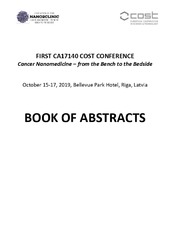Приказ основних података о документу
Surfactant-Assisted Microwave Processed ZnO Nanoparticles with Optimized Surface-to-Bulk Defect Ratio For Potential Biomedical Application
| dc.creator | Stanković, Ana | |
| dc.creator | Drvenica, Ivana | |
| dc.creator | Đukić-Vuković, Aleksandra | |
| dc.creator | Marković, Smilja | |
| dc.date.accessioned | 2021-03-10T14:01:29Z | |
| dc.date.available | 2021-03-10T14:01:29Z | |
| dc.date.issued | 2019 | |
| dc.identifier.uri | http://TechnoRep.tmf.bg.ac.rs/handle/123456789/4167 | |
| dc.description.abstract | Owing to a wide band gap energy (3.37 eV at RT) and a large exciton binding energy (60 meV), ZnO nanoparticles (ZnONP) have a diverse application, e.g. in electronics, optoelectronics, photocatalysis. Besides, ZnONP have a great potential in medicine for bioimaging, drug/gene delivery or as antimicrobial and anticancer agents. One of suggested governing mechanisms of the mentioned biological activities of ZnONP is based on formation of reactive oxygen species (ROS). When ZnONP absorb photon with energy equal or greater than its band gap, electrons are excited from the valence band (VB) to the conduction band (CB) leaving the holes in VB. Furthermore, the photogenerated holes (h+) and electrons (e-) migrate from bulk to surface. The photogenerated holes at the VB react with water molecules adsorbed at the particle surface to produce hydroxyl radical, while electrons in CB react with oxygen molecules generating anionic superoxide radical O2 -•. Superoxide radicals can be transformed in highly reactive OH• and so on [1]. Derivatives of this active oxygen can damage the bacterial/tumor cells [2]. However, in sufficiency ROS can damage normal cells as well. Thus, an understanding of ZnONP crystal structure-activity relationship and mechanism of ZnONP-related products formation and their consequent activity is crucial for the design of safe ZnONP based biomaterial for application in treating diseases like cancer. A series of ZnONP samples were synthesized by microwave processing of precipitate in the presence of a small amount (5 wt.%) of surfactants CTAB and citric acid. The particles crystallinity and purity were investigated by X-ray diffraction, Raman and ATR-FTIR spectroscopy. The particles morphology and texture properties were observed with field emission scanning electron microscopy (FE–SEM) and nitrogen adsorption–desorption isotherm, respectively. The optical properties were studied using UV–Vis diffuse reflectance and photoluminescence (PL) spectroscopy. ZnONP samples with different surface-to-bulk defect ratio were examined on ROS formation and antimicrobial activity. Future studies will be conducted with an aim to correlate surface-to-bulk defect ratio in ZnONP with mechanism of ROS formation and their cytotoxicity to normal and cancerous cells. | sr |
| dc.relation | info:eu-repo/grantAgreement/MESTD/Integrated and Interdisciplinary Research (IIR or III)/45004/RS// | |
| dc.rights | openAccess | |
| dc.rights.uri | https://creativecommons.org/licenses/by-nc-nd/4.0/ | |
| dc.source | Book of Abstracts / First CA17140 COST Conference Cancer Nanomedicine – from the Bench to the Bedsid | |
| dc.subject | ZnO nanoparticles | sr |
| dc.subject | microwave processing | sr |
| dc.subject | antimicrobial activity | sr |
| dc.title | Surfactant-Assisted Microwave Processed ZnO Nanoparticles with Optimized Surface-to-Bulk Defect Ratio For Potential Biomedical Application | sr |
| dc.type | conferenceObject | |
| dc.rights.license | BY-NC-ND | |
| dc.citation.epage | 93 | |
| dc.citation.other | : 93-93 | |
| dc.citation.spage | 93 | |
| dc.identifier.fulltext | http://TechnoRep.tmf.bg.ac.rs/bitstream/id/1871/4164.pdf | |
| dc.identifier.rcub | https://hdl.handle.net/21.15107/rcub_technorep_4167 | |
| dc.type.version | publishedVersion |

